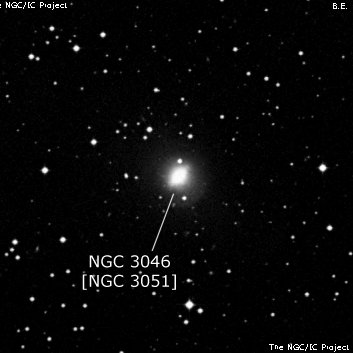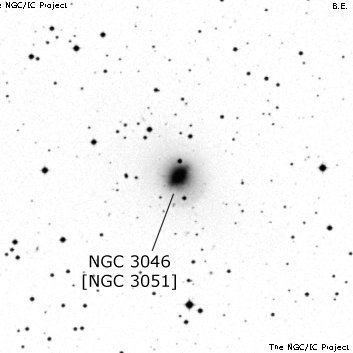NGC/IC Project Restoration Effort
(This is a very very beta version)
NGC3046


Basic Information
Location and Magnitude
Right Ascension: 9:53:20.0
Declination: -27:19:54
Constellation: ANT
Visual Magnitude:
Historic Information
Discoverer: Herschel J.
Year of discovery: 1835
Discovery aperture: 18.3
Observational
Summary description: pF, R, sp of 2
Sub-type: NF
Corwin's Notes
=====
NGC 3046 may be NGC 3051. But if it is, JH has made some strange mistake
since he specifically says in a note in the GC "h3199 [N3046] and 3201 [N3051]
are also distinct nebulae, and were observed consecutively in sweep 562 (h)."
His CGH observation has the note "RA precarious; a hurried observation," and
the Sweep itself, preserved in the Herschel Archive, has the RA marked with a
double colon "::". Otherwise, this observation and that for NGC 3051 just
following are properly reduced and unremarkable.
I'm inclined to believe that the two observations refer to the same object, in
spite of JH's protestations to the contrary. The descriptions are identical
(as far as they go; N3046 is noted only as "pF,R" while N3051 is "pF,S,R,gbM;
20 [arcsec]"), and the positions are not all that much different. There are
two very faint double stars near JH's position for N3046, but they are much
fainter than N3051 and any other double star that I know that JH has mistaken
as a nebula.
This sort of mistake -- measuring the same galaxy twice in the same sweep,
thinking it a different object -- has occured at least twice in his father's
sweeps, and I would not doubt that it appears in JH's, too.
Still, I'm listing the main entry as "Not found", and putting a question mark
on the identity with N3051. Whatever the case, there is certainly only one
bright galaxy here, not two as JH has it.
The galaxy, by the way, is one of the "shell" galaxies, with coronae at
alternating distances on either side of the bright bar. NGC 474 is a dramatic
example; see Turnbull, Bridges, and Carter, MNRAS 307, 967, 1999 where the
shells are interpreted as the result of a merger of at least two galaxies.



